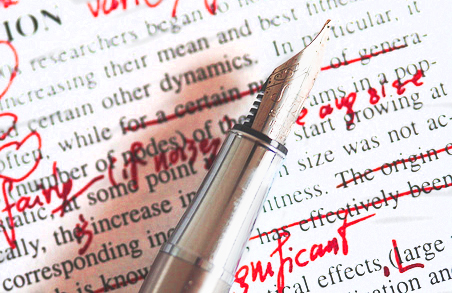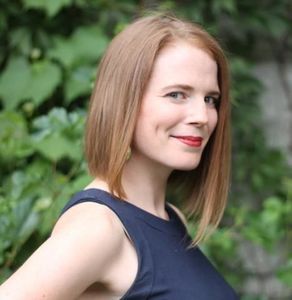What to Expect When You’re Expecting: The Editorial Process for New Writers - Part One
A little while ago, we were contacted by ECW's senior editor, Jen Knoch, with an interesting suggestion for the site. We profile a lot of authors, in all forms and genres, and post a good deal about the writing and publishing process, especially from the perspective of the writer. However, it is rare that we've posted columns or features with a specific focus on the editorial process. Well, we thought that Jen was on to something here, and have asked her to help us shore up this very important component of the writing game.
So, here we have the first part of a two part guest series from Knoch, where she dives deep into what it takes to effectively produce and polish a fully realized book. In these pieces, you'll find some fascinating insights into the world of editing as Jen demystifies this process, and explains what the role of the editor really means. For emerging writers, or those who haven't had a great deal of editorial experience, there are some priceless nuggets for you to ponder as you work toward publication.
Please welcome Jen, and read on to get some editorial wisdom up into your brain...
So you signed your first book contract and it’s time to get down to work. (Unless, of course, your book is perfect. Just kidding: it’s not.) You know there’s some editing to do, but editing can take a lot of forms, and often a writer will only know one side of it. Here’s the editorial perspective on the developmental milestones of your book baby.
Substantive/Structural Editing
I took editing classes at publishing school and learned a lot on the job, but my best editing training came as a lit student: learning to dissect a book, study the parts, and consider the implications. I still approach a new manuscript as a student would, because a good editor is before anything a good reader. All of my edits start with really immersing in the work, which usually means reading it multiple times. At this phase, I’m mostly concerned with the big picture: How is the book structured, and why? Is that choice effective? What is the author trying to say? Why are they saying in in this particular way? Is there too much of something, or not enough? In a novel, the editor will be looking at those major components we all learned in high school English: plot, characters, theme, pacing. Edits of non-fiction may look at some of those things too, as well as argument and subject matter.
Sometimes this early phase involves some doubt and uncertainty if the text is too far from where I think it should be. Am I totally wrong? Why did they make these choices? Are there other ways forward or possible directions? In those cases, I do what I learned in grad school while crying into my coffee over the impenetrability of Judith Butler’s Bodies that Matter: I read the book again. Maybe even again. Then I summarize what I know, make more notes, and when I start to tattoo my notebook pages with arrows and my handwriting devolves into urgent scribbled words, I know I’m getting somewhere. My opinion might only be one reader’s opinion, but I owe it to the writer to make it as carefully informed and considered as possible.
The author usually sees the tip of this iceberg when I send a letter (usually several pages long), saying what I love about the book, and pointing out areas that need work, or new directions that could be explored. This is not an edict, but the beginning of a conversation, which continues by email or over the phone. We might take the plan of action from the letter, or create a new one together, and the author will revise. I’ll read the revised draft again, and, if we’ve gotten closer, start making more specific in-text suggestions. This could go for another round or more, depending on the book, the author, and the extent of revisions.
Line Editing
Sometimes this is a part of substantive editing, and sometimes this is done by a hands-on copy editor, but occasionally a separate pass is needed to focus on flow sentence-to-sentence or how things are working within a sentence. Sometimes it’s modifying tone, and in non-fiction, the language might need some sparkling up, or to be made more or less colloquial. If substantive editing looks at chapters at a time and copy editing looks at a sentence at a time, line editing focuses paragraph by paragraph.
Copy Editing
Here’s where the grammar police come in. But copy editors will do so much more than look at subject-verb agreement and semi-colon usage. They may apply a house style to your book (which considers things such as commas, capitalization, whether numbers are digits or are spelled out, open or closed em dashes), and will build a style sheet that synthesizes the rules for your book and includes a list of all the specific spellings in your book. In novels they’ll track things from a character’s position in space (were they sitting down and now they’re in the kitchen?), to facial hair, to which nicknames are used by which characters, to timelines of events and the release dates of songs on the radio. They should notice if you’ve used the word inchoate eight times, and suggest alternatives. They’ll be attentive to tone, and words that might ring false, especially in dialogue.
They’ll also do some basic fact checking, verifying dates and names and geography, whether a book you referenced wasn’t published yet, or the time zone doesn’t make sense. That said, in my experience, most publishing fact-checking is not as rigorous as is in magazine writing: no one’s calling around to check quotes and facts directly with sources. So if you’re a non-fiction writer, take extra care and hire your own fact-checker if it’s a major concern.
Your CanLit News
Subscribe to Open Book’s newsletter to get local book events, literary content, writing tips, and more in your inbox
Copy editors will present the rules, although some writers may choose to break them for their own reasons. Your substantive editor may be the one to rule on whether you get to rebel. The copy editor or your substantive editor will go over all the revisions you make here.
Proofreading
The book is now in typeset pages, and the pages look much like they will when they’re printed. Both the author and a proofreader will read through, looking for errors, formatting problems (bad line breaks, inconsistent styling). I’d recommend proofing on printouts rather than onscreen. This is not time to tinker, to finesse, to add huge swaths of text if you care for your book and also for your editor’s blood pressure. Generally, the fewer changes the better, since this is an easy place for errors to creep in, despite the best efforts of keen-eyed production editors. So, I repeat, resist the urge to tinker. It can be hard to read your own work at this point, but it’s important to do so, since you’re the expert on your work.
Each of these stages should be done by a different person, because fresh eyes, and fresh perspectives, are important. Editing can be irritating, energizing, inspiring or disheartening, but try to remember that each editor working on your book wants it to be the best it can be, even if you’re the only one who can ultimately decide what that means.
Keep an eye out for part two of Jen's column on the editorial process, coming next month.
Jen Knoch is a senior editor at ECW Press. She has a decade of editorial and publishing experience and has worked with authors including: Neil Peart, Douglas Gibson, Catherine Gildiner, Malka Marom, Josh O'Kane, Alexandra Grigorescu, and Kevin J. Anderson. She is also the co-author of bestselling non-fiction titles for middle grade and young adult readers, some of which explore Taylor Swift. When she is not editing or writing, Jen spends her time as a triathlete, runner, yogi, gardener, and maker of fine soaps.




